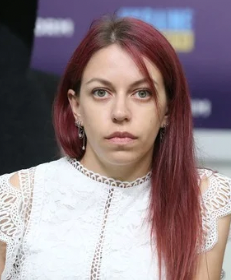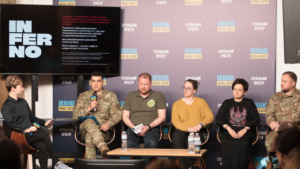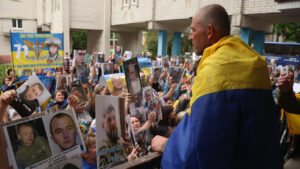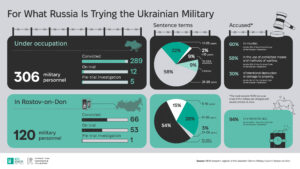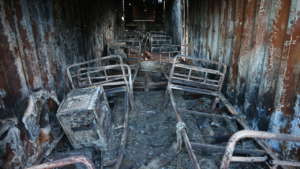The war that destroyed everything: the story of the struggle of Azov brothers

Oleh and Vitaliy Lobovs, twins, both served in the Azov brigade. From the first days of the full-scale invasion, they defended Mariupol. In April 2022, the group, which included the brothers, made a breakthrough to Azovstal and came under fire. Vitaliy Lobov was killed, and Oleh was wounded, reached the metallurgical plant, and a month later, was taken prisoner.
On the night of July 28 to 29, 2022, Lobov and 192 comrades of him were in the Volnovakha Correctional Colony No. 120 (Olenivka), in a building that would later be dubbed “barrack 200” due to the dozens of deaths. That night, several explosions occurred. More than 50 Azov members died, and over a hundred were injured. When Russian media released the lists of the wounded and deceased, Anna Lobova, Oleh’s wife, found her husband on both. Later, it turned out that Oleh had survived. Since then, Anna has been trying to bring her husband home.
Anna and Oleh met in 2020. Even then, he was serving in the Azov brigade. For a long time, they were just friends. Due to Oleh’s service and the fact that they lived in different cities, they met infrequently. Over time, phone calls and correspondence turned into a relationship. Then they had to make a difficult decision — someone needed to move to another city.
“It was easier for me to move, but it was hard to decide to radically change my life. And then I found out I was pregnant. Our daughter decided everything for us,” says Anna Lobova.

Oleh and Anna Lobovs before the full-scale invasion of Russia into Ukraine
Initially, they decided to live in Mariupol, but Oleh was worried that the poor environmental situation in the city would affect the health of their future child. So, Anna moved to Berdiansk. Oleh wanted to transfer and be with his wife, but it didn’t work out. They were together only on weekends and when Oleh had free time.
The Lobovs’ daughter was born shortly before the start of the full-scale invasion, and Oleh was immensely happy. He loved fishing, so he made plans: as soon as his daughter grew up, they would fish together.
Lobov rarely spoke about his service; he was always on missions, and with the beginning of Russia’s full-scale invasion, he rarely made contact.
“Usually, his messages were personal; even his comrades didn’t talk about what was happening. They knew we had a child, so all text messages sounded like this: ‘How are you? What should I send? Oleh is all right’,” says Lobova.
From March 2 to 9, for the first time, there was no contact with Oleh for an extended period. Then, his comrades started sending short messages that everything was fine with Lobov.
In April, a significant part of the Azov fighters, including the Lobovs brothers, and adjacent marine units were cut off on the right bank of Mariupol. They decided to break through to Azovstal. This happened on the night of April 14 to 15. The only way to the other side was an emergency bridge over the Kalmius River, but there were not enough vehicles for everyone, so some of the soldiers crossed the river in boats. When the military almost crossed the bridge, the enemy opened dense artillery fire. Many Ukrainian fighters died then. Among them was Vitaliy Lobov, Oleh’s brother. Oleh was wounded.
“My husband couldn’t save his brother. He searched for him for a long time, hoping that Vitaliy had managed to escape, but unfortunately, he perished. Oleh could no longer stay there; all who survived reached Azovstal,” Anna recounts.

Vitaliy Lobov, Oleh Lobov’s brother, was killed during the Azov fighters’ attempt to break through to Azovstal in April 2022
In Azov, this breakthrough is called ‘the black day in the history of Azov.’
“Oleh always wrote to me: ‘We are fine.’ They [with his brother] were inseparable. On April 15, he wrote to me: ‘I am fine.’ And then I understood that something terrible had happened. I wrote to him: ‘Where is Vitaliy?’ In response, I got this message: ‘I don’t know’.”
In the messages, Oleh wrote to Anna: ‘I tried to find him, but I couldn’t do anything by myself.’ Oleh didn’t mention his injury; Anna only learned about it after some of her husband’s comrades were released from captivity.
“Later, the guys told me that Oleh continued to search for Vitaliy, but due to constant shelling, it was impossible to go there again. When I listen to the stories about that day, I understand how hard it was for Oleh; he tried to help his brother, but he couldn’t. He had to make a decision — stay there or move on.”
“I embrace you tightly”
Contact with Oleh was often lost for long periods of time. When he wrote, he only asked about his daughter: ‘How are you? What is she eating? How is her belly?’
“He only saw her as an infant, so he was very worried about us. The only thing he said about himself was that all his clothes were too big for him. That’s how I understood that he had lost a lot of weight.”
The situation in Mariupol worsened day by day, and Ukrainian defenders at Azovstal were surrounded. On May 16, 2022, media reported the evacuation of severely wounded Ukrainian soldiers from Azovstal. Later that day, Hanna Maliar, Deputy Minister of Defense of Ukraine, announced the start of an operation to rescue the defenders of Mariupol: “On May 6, from Azovstal to a medical facility in Novoazovsk (‘DNR’), 53 severely wounded soldiers were evacuated to receive medical care. Another 211 individuals were transported through a humanitarian corridor to Olenivka (‘DNR’). A procedure for their exchange will be implemented for their eventual return home.”

Ruins of Azovstal, where Mariupol’s defenders held a circular defense in the spring of 2022
Later, a message appeared on Azov’s social media: “To save lives, the entire Mariupol garrison is carrying out a decision approved by the higher military command and hopes for the support of the Ukrainian people.” No one spoke of captivity then. Relatives were assured it was an evacuation to save lives.
“The last SMS from Oleh came on the night of May 16 to 17: ‘I embrace you tightly.’ And not a word that the next day he would be in captivity,” recalls Anna Lobova.
The exit from Azovstal lasted until May 20, 2022. Everyone was transported to the penitentiary institution in the village of Olenivka — Volnovakha Correctional Colony No. 120. Later, some managed to contact their relatives, but there was no news from Oleh. Anna assumes that her husband didn’t want to risk and expose his family to danger, believing that they would be exchanged soon. But that didn’t happen.
On the morning of July 29, 2022, Anna Lobova was the first to write in the Azov family chat about explosions in one of the barracks in Olenivka, where prisoners were held. Others reassured her, saying not to trust Russian news.
“Then a video appeared. Blood-soaked rags, remains of bodies. Then we understood that something was wrong. Although the guys released in June 2022 assured us that it was an industrial zone, that there were no prisoners there. But we saw people in the video. By the end of the day, we realized that our boys had been killed, though we didn’t know who exactly.”
Then Russia published the lists. Anna first came across the list of the deceased. Among 48 surnames, she found Oleh.
Emaciated, injured, but alive
Immediately, a list of the wounded appeared, and Oleh’s name was there too. In the comments, people discussed the lists; there was information that several people had died on the way to the hospital, which could explain the repetition of surnames. There was no official information.
“So we lived in uncertainty,” Anna says. “Another surname also appeared in both lists, but that family almost immediately learned that their son was alive. I only breathed a sigh of relief on August 17 when I saw a video from the hospital.”
In one of the Russian Telegram channels, interviews with wounded Azov fighters appeared. Oleh Lobov was also filmed, but Anna was not entirely sure it was him. She took a screenshot and sent it to all relatives in hopes that she was not mistaken.
“Oleh’s friends started writing to me: ‘Look, a video from another world.’ It really was Oleh, very emaciated, injured, tired, but alive.”
In the video, the man had a bandaged arm, Anna saw many shrapnel wounds on his body and head.

Oleh Lobov in the hospital. Photo: a screenshot from a story on a Russian Telegram channel
“I noticed small scars on his face; they weren’t there before. A very tired look, I had never seen him like that. Other guys were next to him, they all looked terribly emaciated.”
Lobova, like many other relatives, appealed to state authorities and the International Committee of the Red Cross, but there was no information. On June 2, Anna received a message from the National Information Bureau stating that Oleh was confirmed by Russia through the ICRC, but after the explosion in Olenivka, the NIB began to deny this letter.
“They told me it was just a preliminary record of his departure from Azovstal. Officially, he was confirmed as a prisoner of war only on October 17, 2023. All this time I tried to prove everywhere that my husband was in that barrack and that he was alive. I called the ICRC headquarters in Geneva, and they told me: ‘Yes, we sympathize, but they don’t let us in. Don’t believe any lists’,” Anna says.
A chance to save
Uniting in the community ‘Olenivka Community’, relatives of Azov fighters who were in that barrack began their own investigation since neither representatives of the ICRC nor a specially created UN commission were allowed to the colony or to the surviving Azov fighters.
Anna knows that Oleh was transported to Donetsk Hospital No. 15, where he stayed until December 2022. Why so long, she does not know, many wounded Azov fighters were returned to Olenivka in September. Information from Oleh’s exchanged comrades is also scarce.
According to information from Ukrainian military personnel released from captivity, Oleh was taken from the hospital in December 2022, supposedly to one of the colonies in Donetsk region. However, where Oleh Lobov is currently located is unknown.
It is also unknown what injuries Oleh received in Mariupol and after the explosions in the colony. But Anna knows that even minor injuries can become life-threatening in captivity.
“In hospitals, they provided medical assistance, but it was inadequate because those medical facilities are limited in resources. There are still guys in captivity with amputations, with limbs that don’t work, some need surgeries. We are losing time to give already crippled people a chance to live at least a somewhat normal life.”

Anna Lobova (right) at an event for families of imprisoned Azov fighters
For two years now, Anna and her little daughter have been waiting for Oleh to return home. Despite the fact that Oleh saw his daughter when she was only a month old, the woman is confident that her husband would recognize her even in a crowd — she is a spitting image of her father.
Currently, Anna lives in Zhytomyr region, where Oleh is originally from. He often told her about the wonderful nature there, but as long as her husband is in captivity, Anna cannot fully appreciate its beauty.
“I walk around the city and tell myself that my eyes are looking at your city, but amidst this crowd of people, I feel empty. I see everything he told me about, but it’s even harder because he is still not by my side.”
Anna Lobova, like many other families waiting for the return of their loved ones from captivity, hopes that the international community will pay attention to the condition of the Ukrainian prisoners of war and help bring them home.
This project is being implemented with the support of Veteran Hub. The organization may not share the opinions expressed within the project.



